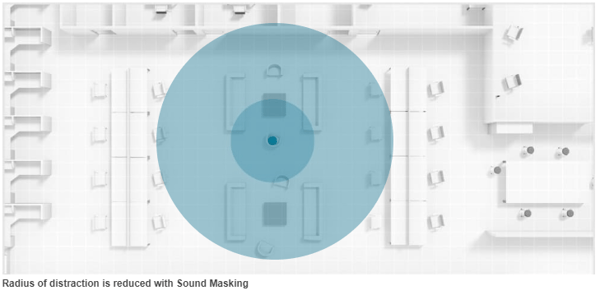What is sound masking? It is the process of adding background sound to reduce noise distractions, protect speech privacy, and increase comfort.

This may seem counter-intuitive, adding sound to make a space seem quieter - but it really works. The added sound reduces the ability for you to understand and pick up human speech. When you can't understand what someone is saying, you are less likely to be distracted by them, and more likely to tune them out completely.
Sound masking is an ambient sound, much like the sound of airflow, but it is engineered to mimic the frequency of human speech so that you can target conversational distractions and make them less distracting. That being said, sound masking does not cancel sound or completely eliminate speech noise in the environment, it just reduces the impact of conversations and limits how far away they can be heard and understood by others (called the radius of distraction).
Sound Masking vs White Noise
| White Noise | Sound Masking | |
| When Amplified... | Sounds like loud AM radio static - irritating! | Has a sound similar to airflow - unobtrusive and fades into the background |
| Includes... | All frequencies at equal energy | Only frequencies of human speech |
| Acoustically... | When used is distracting and annoying | When used is comfortable, increases privacy, and minimizes distraction |
White noise machines are localizable. That is, you can tell where the sound is coming from. Just like a fan, your ears can pinpoint where the machine is, which can be more of a distraction than a help.
Sound masking systems are an immersive experience, because the sound isn't centralized - it comes from everywhere. There shouldn't be gaps in sound masking when you walk around your space, and should have a constant sound field whether you're sitting or standing.
Sound Masking is an Immersive Experience
Sound masking, when installed, has a very detailed installation plan. The plan accounts for:
- Size of room
- Light fixtures
- Wall textures/materials/coverings
- Material of your ceiling
- Furniture/furnishing within the room
All of these factors are taken into consideration, and a design is implemented with appropriate spacing of speakers (emitters) and adjustments to the intensity of the sound masking.
In what environments is sound masking useful?
- Open Office Plans. It improves speech privacy in office spaces, minimizes distractions of other conversations, and allows for better efficiency.
- Private Offices. Offices and huddle spaces benefit from sound masking because it will render private conversations completely unintelligible - no matter how thin the walls are. It also keeps thought flowing because outside distractions are eliminated.
- Public Spaces. Places like waiting rooms, banks, hospital rooms and hallways, etc. need sound masking technologies to protect privacy and comply with requirements from HIPAA and GLBA regulations.
Interested in seeing how sound masking can help your space? Submit your information in the form below and we can set something up!



